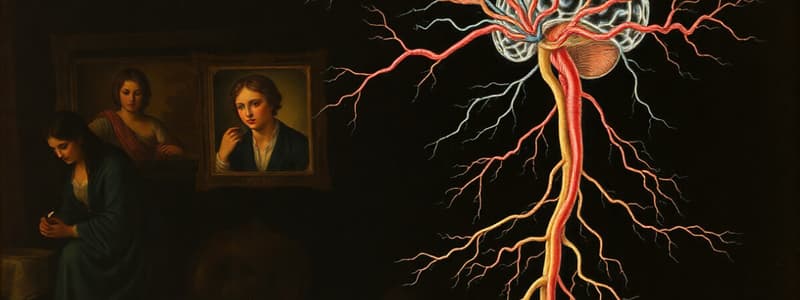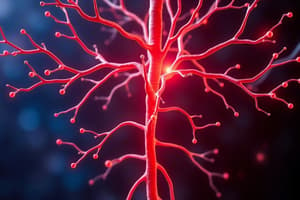Podcast
Questions and Answers
Which neurotransmitter is released by cholinergic neurons?
Which neurotransmitter is released by cholinergic neurons?
- Acetylcholine (correct)
- Dopamine
- Serotonin
- Norepinephrine
The sympathetic nervous system promotes rest and digest activities.
The sympathetic nervous system promotes rest and digest activities.
False (B)
Name the part of the brain that regulates the endocrine system.
Name the part of the brain that regulates the endocrine system.
hypothalamus
The two types of cholinergic receptors are ____________________ and ____________________.
The two types of cholinergic receptors are ____________________ and ____________________.
Which adrenergic receptors are responsible for the body's response to norepinephrine?
Which adrenergic receptors are responsible for the body's response to norepinephrine?
Match the cranial nerves with what they innervate:
Match the cranial nerves with what they innervate:
Which of the following receptors are responsible for sensing pain from internal organs?
Which of the following receptors are responsible for sensing pain from internal organs?
Norepinephrine is the neurotransmitter released faster than acetylcholine.
Norepinephrine is the neurotransmitter released faster than acetylcholine.
Interoceptors are responsible for sensing external stimuli.
Interoceptors are responsible for sensing external stimuli.
What part of the brain controls the muscular system?
What part of the brain controls the muscular system?
What is the role of proprioceptors in the body?
What is the role of proprioceptors in the body?
The gyri in the brain that receive sensory information is called the ______.
The gyri in the brain that receive sensory information is called the ______.
Which type of receptor detects changes in chemical concentrations like oxygen and carbon dioxide?
Which type of receptor detects changes in chemical concentrations like oxygen and carbon dioxide?
Match the type of receptor with its function:
Match the type of receptor with its function:
The precentral gyri in the brain are responsible for receiving sensory information.
The precentral gyri in the brain are responsible for receiving sensory information.
How do sensory receptors determine important information from background stimuli?
How do sensory receptors determine important information from background stimuli?
What type of information do ascending pathways transmit?
What type of information do ascending pathways transmit?
Descending pathways transmit sensory information from the brain to the body.
Descending pathways transmit sensory information from the brain to the body.
What term is used for pain perceived at a location other than the actual site of the painful stimulus?
What term is used for pain perceived at a location other than the actual site of the painful stimulus?
The __________ is a representation of body parts and their corresponding sensory and motor functions.
The __________ is a representation of body parts and their corresponding sensory and motor functions.
Which cranial nerve is associated with the special sense of smell?
Which cranial nerve is associated with the special sense of smell?
Damage to the motor cortex can lead to sensory loss.
Damage to the motor cortex can lead to sensory loss.
Which cortex damage results in loss of sensation?
Which cortex damage results in loss of sensation?
Match the cranial nerve to its associated special sense:
Match the cranial nerve to its associated special sense:
What is a neuromuscular junction?
What is a neuromuscular junction?
A preganglionic neuron has its cell body in the ganglion.
A preganglionic neuron has its cell body in the ganglion.
What neurotransmitter is released at the preganglionic neurons of both the sympathetic and parasympathetic divisions?
What neurotransmitter is released at the preganglionic neurons of both the sympathetic and parasympathetic divisions?
Norepinephrine is released at the postganglionic ______ division.
Norepinephrine is released at the postganglionic ______ division.
Match the following terms with their descriptions:
Match the following terms with their descriptions:
What effect does diabetes have on the peripheral nervous system?
What effect does diabetes have on the peripheral nervous system?
Beta blockers are used to increase blood pressure.
Beta blockers are used to increase blood pressure.
What is the thoracolumbar part of the ANS?
What is the thoracolumbar part of the ANS?
Which cranial nerve is responsible for special sense vision?
Which cranial nerve is responsible for special sense vision?
The vestibulocochlear nerve is associated with hearing and balance.
The vestibulocochlear nerve is associated with hearing and balance.
What is the primary function of the membranes that cover the special senses?
What is the primary function of the membranes that cover the special senses?
Lacrimal glands produce tears, which flow across the eye and drain through the __________ duct.
Lacrimal glands produce tears, which flow across the eye and drain through the __________ duct.
Which of the following is NOT one of the main structures involved in the hearing process?
Which of the following is NOT one of the main structures involved in the hearing process?
Match the sensory organs to their corresponding functions:
Match the sensory organs to their corresponding functions:
What are the five basic taste sensations?
What are the five basic taste sensations?
Aging has no effect on taste bud sensitivity.
Aging has no effect on taste bud sensitivity.
Flashcards
Cholinergic receptors
Cholinergic receptors
Receptors that bind with acetylcholine.
Adrenergic receptors
Adrenergic receptors
Receptors that bind with norepinephrine.
Autonomic nervous system neurotransmitters
Autonomic nervous system neurotransmitters
Acetylcholine and Norepinephrine
Sympathetic nervous system's effect
Sympathetic nervous system's effect
Signup and view all the flashcards
Parasympathetic nervous system's function
Parasympathetic nervous system's function
Signup and view all the flashcards
Hypothalamus's role
Hypothalamus's role
Signup and view all the flashcards
Motor cortex function
Motor cortex function
Signup and view all the flashcards
Vagus nerves innervate
Vagus nerves innervate
Signup and view all the flashcards
Neuromuscular Junction
Neuromuscular Junction
Signup and view all the flashcards
Preganglionic Neuron
Preganglionic Neuron
Signup and view all the flashcards
Postganglionic Neuron
Postganglionic Neuron
Signup and view all the flashcards
Neurotransmitter: Acetylcholine
Neurotransmitter: Acetylcholine
Signup and view all the flashcards
Neurotransmitter: Norepinephrine
Neurotransmitter: Norepinephrine
Signup and view all the flashcards
Diabetes Nerve Damage
Diabetes Nerve Damage
Signup and view all the flashcards
Thoracolumbar Division of ANS
Thoracolumbar Division of ANS
Signup and view all the flashcards
ANS Reflex Arc Sequence
ANS Reflex Arc Sequence
Signup and view all the flashcards
Sensory Neuron Function
Sensory Neuron Function
Signup and view all the flashcards
Sensory Information Pathway
Sensory Information Pathway
Signup and view all the flashcards
Interoceptors
Interoceptors
Signup and view all the flashcards
Thermoreceptors
Thermoreceptors
Signup and view all the flashcards
Nociceptors
Nociceptors
Signup and view all the flashcards
Baroreceptors
Baroreceptors
Signup and view all the flashcards
Proprioception
Proprioception
Signup and view all the flashcards
Somatic Information
Somatic Information
Signup and view all the flashcards
Ascending pathways
Ascending pathways
Signup and view all the flashcards
Descending pathways
Descending pathways
Signup and view all the flashcards
Referred pain
Referred pain
Signup and view all the flashcards
Sensory homunculus
Sensory homunculus
Signup and view all the flashcards
Motor homunculus
Motor homunculus
Signup and view all the flashcards
Sensory cortex damage
Sensory cortex damage
Signup and view all the flashcards
Motor cortex damage
Motor cortex damage
Signup and view all the flashcards
Olfactory nerve
Olfactory nerve
Signup and view all the flashcards
Optic Nerve
Optic Nerve
Signup and view all the flashcards
Retinal Epithelium
Retinal Epithelium
Signup and view all the flashcards
Vestibulocochlear Nerve
Vestibulocochlear Nerve
Signup and view all the flashcards
Sensory Organ Membranes
Sensory Organ Membranes
Signup and view all the flashcards
Lacrimal Production Pathway
Lacrimal Production Pathway
Signup and view all the flashcards
Eye Layer Structure & Function
Eye Layer Structure & Function
Signup and view all the flashcards
Hearing Structures & Function
Hearing Structures & Function
Signup and view all the flashcards
Balance System Structures & Function
Balance System Structures & Function
Signup and view all the flashcards
Study Notes
Chapter 15, 16, 17 Test - Study Notes
- Autonomic Nervous System Receptors:
- Cholinergic receptors (bind ACh): nicotinic and muscarinic
- Adrenergic receptors: a1, a2, b1, b2, b3
- Neurotransmitters:
- Cholinergic neurons release acetylcholine.
- Adrenergic neurons release norepinephrine.
- Acetylcholine is released faster than norepinephrine.
- Norepinephrine is more widespread.
- Brain Regions and Functions:
- Hypothalamus: regulates endocrine system
- Motor Cortex: regulates muscular system
- Medulla: regulates cardiac system
- Brainstem: regulates respiratory system
- Parasympathetic system: regulates digestive system
- Spinal Cord: part of the central nervous system
- Sympathetic vs Parasympathetic Systems:
- Sympathetic system: prepares the body for "fight or flight"
- Parasympathetic system: promotes "rest and digest" activities
- Cranial Nerves:
- Glossopharyngeal nerve: innervates tongue and pharynx
- Oculomotor nerve: innervates the eye
- Vestibulocochlear nerve: innervates the inner ear (hearing and balance)
- Neurotransmitters in Autonomic Nervous System:
- Acetylcholine and norepinephrine are released by autonomic nerves.
- Neuromuscular Junction:
- Point of contact between motor neuron and muscle fiber
- Allows nervous system to control muscle contraction.
- Neurons:
- Preganglionic neuron: cell body in the brain or spinal cord
- Postganglionic neuron: runs from ganglion to the effector
- Neurotransmitter Acetylcholine:
- Released at preganglionic neurons in the autonomic system.
- Sensory Receptors:
- Transmit sensory information from receptors to the central nervous system.
- Sensory Pathway:
- Sensory information travels via ascending pathways.
- Motor responses travel via descending pathways.
- Internal Receptors:
- Interoreceptors: detect internal stimuli (e.g., changes in body temp).
- Chemoreceptors: detect chemical concentration changes.
- Osmoreceptors: detect osmotic pressure of fluids.
- Baroceptors: detect blood pressure changes.
- Proprioceptors: detect body position and movement.
- External Receptors:
- Photoreceptors: detect light.
- Mechanoreceptors: detect touch, pressure, and vibration.
- Nociceptors: detect pain.
- Thermoreceptors: detect temperature changes.
- Brain Areas and Functions:
- Precentral gyrus: Receives and processes motor information.
- Postcentral gyrus: Receives and processes somatosensory information.
- Sensory Cortex: Processes sensory stimuli.
- Motor Cortex: Plans and executes voluntary movements.
- Pain Perception:
- Referred pain: Pain perceived in a location other than the source of the stimulus.
- Visceral pain: Pain originating from internal organs which is misinterpreted by the brain.
- Cranial Nerves and Special Senses:
- Olfactory nerve: special sense of smell; epithelium found on the inferior surface of the cribriform plate.
- Optic nerve: special sense of vision; retinal epithelium located within the eye
- Vestibulocochlear nerve: special sense of hearing; epithelium within the inner ear.
- Glossopharyngeal nerve: special sense of taste; epithelium on the tongue.
- Special Sense Membranes & Functions:
- Membranes covering special senses in the body, and functions in detecting different stimuli.
- Lacrimal Production Pathway:
- Lacrimal glands produce tears; flow through the eye and drain to the nasolacrimal duct.
- Eye Structure:
- Describes the layers and structures of the eye.
- Hearing Structures:
- Descriptions of auditory structures and their functions.
- Balance System Structures:
- Structures in the balance system and their functions.
- Taste Perception Changes with Age:
- Age-related decline in taste perception due to changes in taste buds and their sensitivity.
Studying That Suits You
Use AI to generate personalized quizzes and flashcards to suit your learning preferences.
Related Documents
Description
This quiz covers essential concepts found in Chapters 15, 16, and 17 related to the Autonomic Nervous System. Key topics include receptors, neurotransmitters, brain functions, and the roles of the sympathetic and parasympathetic systems. Test your knowledge on how these systems interact and support bodily functions.




